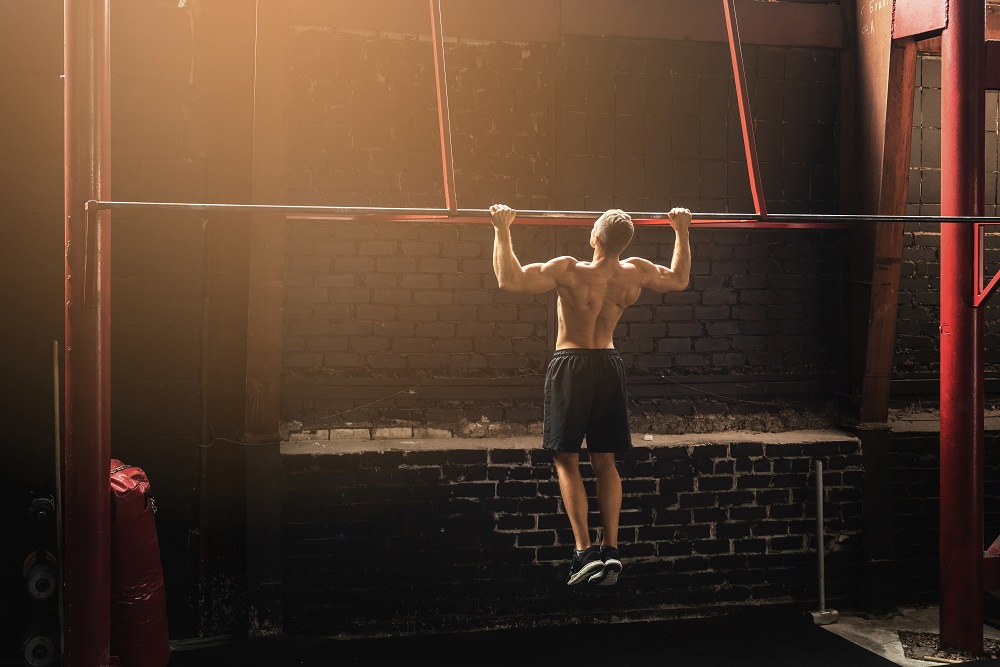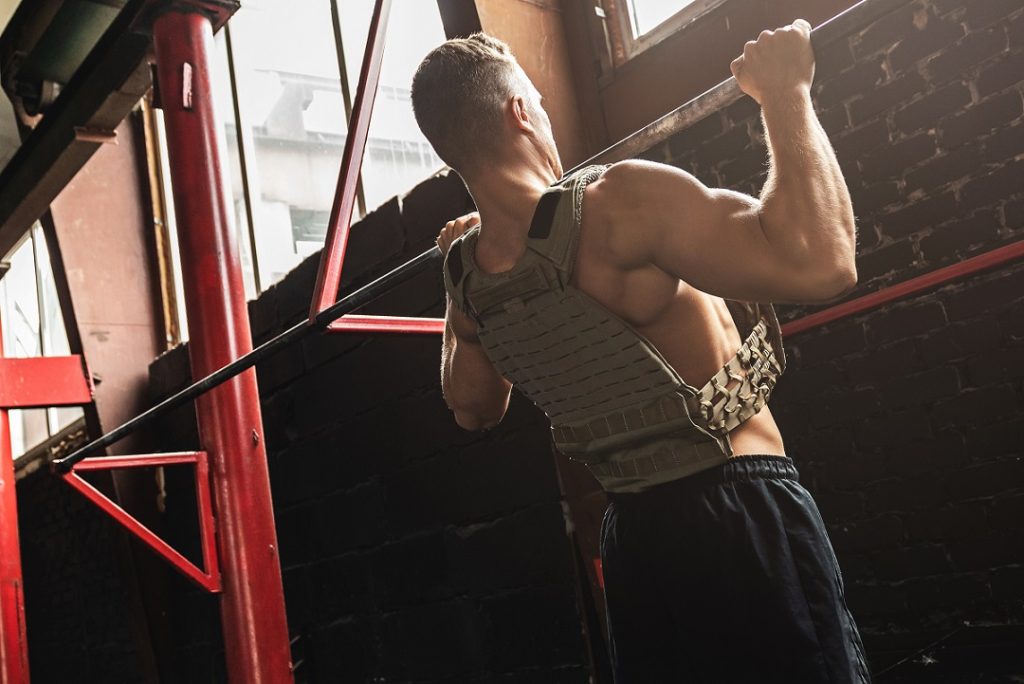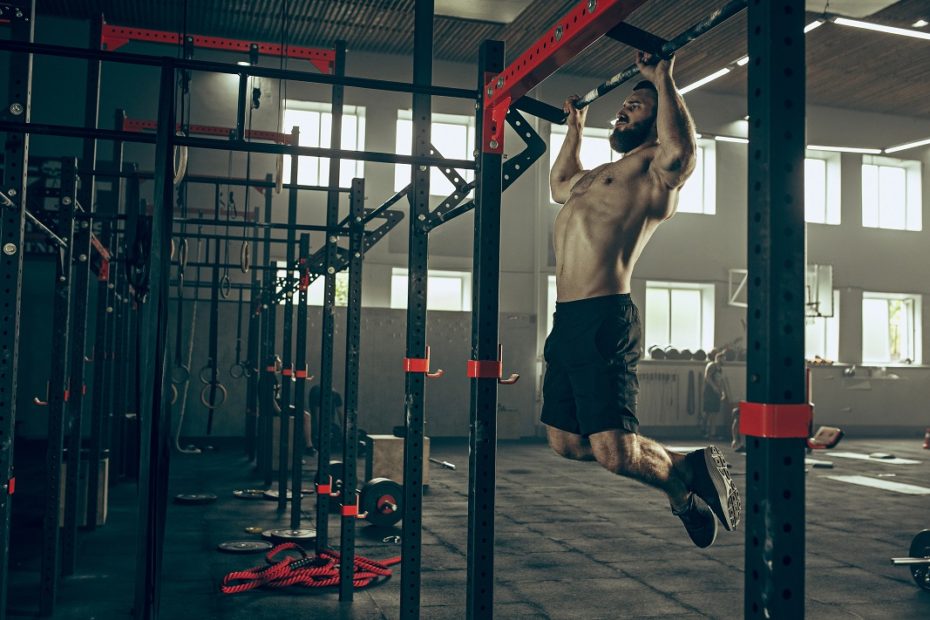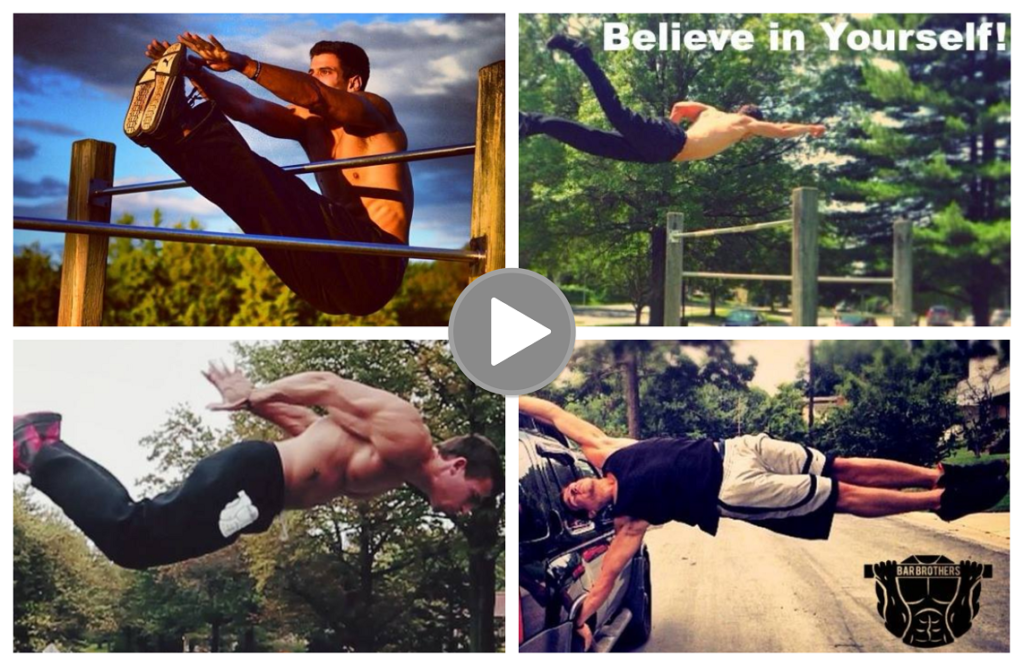Disclosure: This post contains affiliate links. Meaning if you click on a link and make a purchase, I'll earn a small commission at no extra cost to you.
When I was around 13 years old, I bumped into an old school friend at the local gym doing some pull up bar workouts with his older brother.
We talked for a few minutes about things like bodyweight training and pullup progressions until finally, he popped the question.
No not that question.
“How many pull-ups can you do mate?”
“Dunno” I said…
Now at that point, I’d never done a single pull up in my life.
Most of my time was spent on the machines at the gym.
So the thought of hanging from a bar in front of everybody while I made feeble attempts to pull myself up wasn’t my idea of a fun workout.
But on this day, I thought I’d give it a go.
Anyway, after around 20 seconds of grunting and awkward facial expressions.
Guess how many reps I got?
A big fat ZERO.
To be honest I was a little embarrassed.
But that embarrassment lit a fire inside me that would drive me to one of the greatest accomplishments of my life.
Straight after I told my friend…
“I’m gonna come back next week and do 5 reps”
So, determined I walked away with a mission that in just 7 days’ time. I’d be back to crank out at least 5 full reps on the bar.
Now what my friend didn’t know, is that my dad recently bought a pullup bar that he hung above the door to the spare bedroom.
And in the 7 days that followed, I made it a habit of practicing pull-ups every single time I walked past that bar.
Anyway…
Next week rolled around and I’m back at the gym doing my usual thing.
Again, I see my old school buddy with his older brother hitting the weights.
So, I walk over and after a little conversation, we head over to the pull-up station for the ultimate test.
I get underneath the bar…
…One …Two …Three …Four …Five …Six
…Six and a half.
Six and a half reps in ONE WEEK.
I’m not gonna lie…
I was one happy dude.
I’d gone from zero pull-ups to a very respectable 6 reps (and a half) in just 7 days.
And that’s when my love for the pullup bar began.
Table of Contents
Introduction To Pullup Bar Workouts
Anyway…
20 years and many workouts later.
Pull-ups still play a huge part in my life.
I can’t think of a single exercise that offers both the simplicity and variety you get from nothing more than a bar and your own bodyweight.
Which is why today I’m sharing all my best-kept secrets from the bar and beyond.
From basic progressions…
…advanced pull-up variations.
…even core workouts and isometric holds that can bend the fabric of space and time.
I’ve included it all in this extensive list of pull up bar workouts below.
WATCH VIDEO: How To QUICKLY Master The Planche, Muscle-Up, Human Flag, And Other Advanced Calisthenic Moves That Defy The Law Of Gravity
(Video Will Open In A New Window)
Pullups vs Chinups
If you’re new to pull-up bar workouts then you need to start here.
This is ground zero when it comes to learning how to do a pull-up.
Now the 2 most basic forms of exercise you can do on a bar are both…
…pullups.
…and chin-ups.
The only difference between the two is the position of your hands.
…Pullups are performed with your palms facing forward.
…Chin-ups are performed with your palms facing towards you.

For most people, chin-ups tend to be the easier variation of the two.
The reason being is that you get more help from your biceps which takes some of the stress away from your lats.
So, if you want to make things a little simpler then I’d recommend starting with chin-ups.
Basic Pull Up Bar Workouts & Pull-up Progressions
Now, before attempting your first pullup. It’s wise to get an idea of your current level of strength.
So, what you need to do first is to test your ability to hang from the bar.
This is called a dead-hang.

Performing a dead-hang will give you a great indication of your current level of strength.
If you CAN’T do it for more than a few seconds then you need to practice until you can hold a strict dead-hang for more than 10 seconds…
…preferably more.
Negatives
As you get better at dead-hangs, you’ll then want to start adding some negative pullups to your routine.
This will allow you to start working through the muscle groups needed to perform a full pullup.
A negative pull-up is just the lowering phase of the movement.
It’s kind of like a built-in safety feature of our body that helps us lower things in a slow and controlled manner.
And because of this it’s a lot easier than performing the positive phase of a pullup.
So, to do a negative…
…find yourself a chair or something stable to stand on
…grab the bar
And hold yourself steady at the top of a pullup.
Once you’re in position, remove your feet from the platform you’re using, and slowly lower yourself into the dead-hang position.
Then just rinse and repeat until you’ve got the hang of it.
Scapula Pulls
Next up you’ve got scapula pulls.
Now you won’t find this exercise in your standard Men’s Health or Shape Magazine because for some reason it’s not deemed essential.
I tend to disagree.
Scapula pulls, although tedious are the foundation of starting a pullup from the correct position.
And if you don’t learn to engage your scapula.
You’ll miss out on developing muscles used for proper movement patterns.
This will set you back when you start attempting more advanced pull-up bar workouts.
So, here’s how to do it…
Get yourself into the dead-hang position with your palms facing forward and your hands shoulder-width apart.
At this point your scapula (shoulder blades) should naturally be fully protracted. (see image)
Keeping your arms straight…
…pull your shoulder blades forward in a kind of reverse shrugging motion.
Fully engaging your lats until your scapula is retracted.

Hold for a second and then return to the starting position.
Perform 6-10 reps for a total of 3 sets.
Pullup Progression
If you’ve put the work in.
You SHOULD have the strength to attempt a full range pull-up.
A few things you should know before you start.
Like I mentioned earlier, the chin-up is usually easier to do than the pull-up.
The closer together your hands are, the more bicep activation you’ll get.
This will make the chin-up easier.
So your best bet is to start with a narrow grip chin-up.
Also, your breathing plays a big part which I’ll take you through in a second.
So, here’s how to do it…
…From a dead-hang position, take a deep breath.
…Start to protract your scapula while pulling yourself up towards the bar.
…Exhale slowly on the way up until your chin is fully above the bar.
…Lower yourself in a slow and controlled manner until you reach the dead-hang position.
…Repeat 1 million times… or 10, I forget.
WATCH VIDEO: How To QUICKLY Learn Advanced Calisthenics Exercises Including The Planche, Muscle-up, Human Flag & More…

Anyway, as you get better, you can then start playing around with the position of your hands to increase the difficulty of the exercise.
You’ll be surprised at how difficult a wide grip pull-up is compared to a close grip chin-up.
Using Leverage To Your Disadvantage
An easy way to keep progressing with the pullup is by using leverage to your advantage.
It’s also a great stepping stone to learning more of the advanced pull-up bar workouts that I’ll be taking you through soon.
But for now, here’s something you can do to take your pullup game to the next level.
It’s called the archer pullup
It’s simple really…
Just get yourself into a wide pull-up (or chin-up) position.
Only now, you want to shift your weight slightly to one side.
This is going to increase the load on one side of your body while taking the stress away from the other.
Perform one pullup. Making sure you keep your weight to one side for the entire repetition.
Repeat on the other side and continue to switch until you’ve completed your required amount of reps.
To start with, you’ll want to only slightly distribute your weight to one side.
Maybe putting around 60 percent of your weight on your working arm.
As you get stronger though, you can continue to play around with the percentages by shifting your body weight to make the exercise harder.
Advanced Pull Up Bar Workouts
Here’s where we start to take things up a gear.
Now before you even think about attempting any of the moves below.
You should be able to do at least 10 strict pullups with perfect form.
If you can’t then go back to the previous pullup progression until you’ve built up the strength needed to move forward.
To be fair these pull up bar workouts are like the basic ones we talked about earlier.
Only now you’re gonna be working on single-arm progressions.
The only difference really is that it requires a lot more…
…core strength.
…and grip strength.
So here’s what to do…
One Arm Dead-Hang

The first time I tried a one arm dead-hang I couldn’t even hold it for a second.
And this is despite being able to do multiple reps of all the previous pull up variations we’ve already discussed.
So here’s how to overcome this little hurdle.
Grab the bar with both hands (shoulder-width apart) with your palms facing forward.
Slowly squeeze the bar tightly with one hand while easing your grip on the other.
As you do, your weight should distribute itself towards your tightly squeezed hand.
Hold for around 3-5 seconds before alternating sides and repeat for another 3-5 seconds.
If you’re doing it right. You’ll notice that as you transfer your weight your body will start to slowly rock from side to side every time you alternate hands.
In time you’ll eventually be able to let go of the bar completely with one hand.
So just keep repeating the process until you can commit to a full one-arm dead-hang for at least 15 seconds on each arm.
Quick tip…
A big problem I found when working through these progressions was a lack of grip strength.
My grip would always give out before my arms got tired and it slowed my progress down.
To combat this, I recommend getting yourself a set of fat gripz to increase the diameter of the bar.
By using a set of fat gripz during your regular pull-up bar workouts. Your grip strength will get a lot better without any extra grip strengthening exercises.
It’s a great time saver.
WATCH VIDEO: How To QUICKLY Learn Advanced Calisthenics Exercises Including The Planche, Muscle-up, Human Flag & More…
One Arm Negative
To make things safer, you need to approach the one arm negative a little differently than before.
Hold the pull-up bar with both hands using a close grip.
I recommend having your palms facing toward you because as you already know…
…chin-ups are way easier.
Anyway…
Perform a single close grip chin up and hold your position at the top of the bar.
As you do, Squeeze the bar tightly with one hand while slowly releasing your grip on one hand until your supporting your weight with just one arm.
Hold for a second, then lower yourself down as slowly and controlled as you can manage.
Like with anything else learning new skills like this takes time so don’t worry if you don’t get it the first time.
Just keep working at it and eventually, your body will adapt to follow suit.

One Arm Scapula Pulls
At this point, you should have the grip strength (and arm strength) to be able to hold a solid one arm dead-hang for at least 15 seconds.
If you don’t, go back and work on your dead-hang until you’ve got it nailed.
So again, get yourself into a one-arm dead-hang with your palms facing forward.
As you hang, depress your scapula in reverse shrugging motion until your scapula is fully protracted.
Hold for a brief second before fully retracting your scapula and repeat.
Quick tip…
If you struggle with this move then there are 2 things you can do…
…Weighted two-arm scapula pulls:
Get yourself a dip belt and load it with roughly half your body weight.
This will help you get used to performing the exercise with more weight. Making it easier when you transition over to the one arm scapula pull.
…Use your other arm to assist:
Basically, just grab your wrist or arm with your free hand to support your weight…
…Or
…Wrap a resistance band around the pull-up bar and again, use your free hand to support your weight.
Go for 6-10 reps for 3 sets before moving on.
One Arm Pull Up Bar Workouts & Pullup Progressions

If you’ve done everything right till now and follow the progressions to the letter.
You should be more than prepared to tackle this beast.
So again, here’s what to do…
….Grab the bar with your palms facing forward and hold a dead-hang.
…Depress your shoulders while pulling yourself up. As you do, your free arm should be straight while your opposite shoulder (non-loaded side) should come up to meet the bar as you get to the top of the pullup.
…Hold for a brief second before lowering yourself back down.
…Congratulate yourself by throwing a party with beer and cake.
Seriously though, if you’ve made it this far give yourself a huge pat on the back. You’ve earned it.
But, we’re not done quite yet.
I’ve still got a few more pull up bar workouts to show you that go beyond basic pulling movements.
Keep reading…
Taking Your Pull Up Bar Workouts To The Next Level
Once you’ve mastered all the pull-up progression above.
There are a few more exercises you can do to add more depth to your pull up bar workouts.
These include…
…L-Sit Pull-ups
…Muscle-ups
…Front Levers
…Back Levers
If you want to start learning these moves. Bar Brothers have a great calisthenics program that shows you how to get yourself up to speed with all the above.
Also, you’ll learn how to perform every single advance calisthenics exercise known to man.
Including the One arm pushup…
…Planche
…Human flag.
…And lots more
Check out the program in the video below…
FREE VIDEO: How To QUICKLY Master The Planche, Muscle-Up, Human Flag, And Other Advanced Calisthenic Moves That Defy The Law Of Gravity
(Video Will Open In A New Window)
To sweeten the deal, if you buy the program using THIS LINK or any other link on this page.
I’ll also throw in my own collection of training manuals worth over $100.
This includes…
…HIIT to Fit
…Functional Strength
…And Kettlebell Transformation
Just send me proof that you joined the program (screenshot or receipt) via the contact page on my website or email me at dan@un-ripped.com.
And I’ll send you EVERYTHING you see below directly to your email address ASAP.

What About Abs
Now, what kind of blog post would this be without throwing a little ab work into the mix?
Here are some progressions that you can add to your pull up bar workouts to really target your abs.
Knee Raises

This is the first abdominal progression you should be attempting on a pullup bar.
But this doesn’t mean it’s easy.
To do it, hold the bar with your hands shoulder-width apart and your palms facing forwards.
Hold a dead-hang position (arms straight).
Then without swinging, slowly lift your knees toward your chest.
Hold for a brief second before lowering your legs back down.
Quick tip…
To increase the effectiveness of the exercise, perform a twisting motion as you raise your legs towards your chest.
This’ll bring your knees further to one side and while further engaging your obliques.
Leg Raises

These are like the knee raise, only now you’re making your abs work harder by raising your legs.
Again, holding a dead-hang position, slowly raise your legs until they’re a 90-degree angle to your body.
Hold for a quick second then slowly lower your legs. keep your core engaged at all times.
As you get stronger start trying to hold the 90-degree L-sit position for as long as you can
This is where the most core activation takes place.
What you can also do, is add the L-sit to your pull up workout.
Just do a pullup. Only now, hold the L-sit position as you work through your set.
Works great…
Sample Pull Up Bar Workouts

To finish things up I’m gonna take you through some of my own personally pullup bar workouts that I regularly do at home.
I always like to change things up a little but most of the time my workouts always involve 2 things…
They are…
…Drop sets
…and Supersets
Drop Sets
Drop sets are when you start with a more advanced variation of a move (or more weight) and slowly regress as your body gets tired.
It’s used a lot in weightlifting.
Someone would start with for example a 40-pound dumbbell for bicep curls.
What they’d do then is max out on reps before lowering the weight.
They’d do AMRAP (as many reps as possible) using the 40-pound dumbbell
Put down the weight and the pick-up let’s say, a 30-pound dumbbell and max out again.
They’d keep doing this until they were maxing out with a really low weight. (maybe 10-pound dumbbells)
This is great for increasing your work volume and training capacity.
Which is why it’s also great to add to your pull up bar workouts.
So, here’s what I do…
After a quick warmup, I’ll start my routine by maxing out with a WIDE GRIP archer pullup.
Because I do a lot of volume in quick succession, I like to leave a rep or two in the tank so I don’t completely fail as I regress through my pullups.
So, after wide grip archer pullups, I’d rest for around 15-30 seconds and then go into wide grip archer chin-ups (slightly easier variation).
Again, resting between 15-30 seconds.
Then all I do is is continue to regress to easier pull-up variations until I’m finally maxing out on close grip chin-ups.
The whole thing looks like this…..
…Wide grip archer pullup
…Rest 15-30 seconds
…Wide grip archer chin-up
…Rest 15-30 seconds
…Medium grip pullup
…Rest 15-30 seconds
…Medium grip chin-up
…Rest 15-30 seconds
…Close grip pullup
…Rest 15-30 seconds
…Close-grip chin-up
It’s a lot of work, but I find it really pushes you to break through plateaus in your training.
Supersets

Another thing I like to do is use supersets my pull up routine.
Basically, I’ll do a set of pullups. Then I’ll work on an opposing muscle group like pushups or dips straight after doing a set of pullups.
Not only does this provide a full upper body workout.
It allows the muscles I use for pullups to rest while I perform a pushing exercise.
This keeps my heart rate elevated while allowing me to get more work done in less time.
The whole thing looks something like this…
…Pullups (hard variation)
…Uneven Parallel Bar Dips
…Pullups (hard variation)
…Pushups (hard variation)
…Pullups (slightly easier variation)
…Standard Parallel Bar Dips
…Pullups (easiest variation)
…Max Pushups (or another hard variation depending on how I’m feeling)
Nothing fancy, just working with the basics to the best of my ability.
If you do the same, I’m sure in time you’ll become the ultimate pull-up king (or queen)
Anyway, that about wraps things up for this blog post…
Any thoughts?
Drop them in the comments section below and I’ll see you soon.
WATCH VIDEO: How To QUICKLY Master The Planche, Muscle-Up, Human Flag, And Other Advanced Calisthenic Moves That Defy The Law Of Gravity
(Video Will Open In A New Window)

